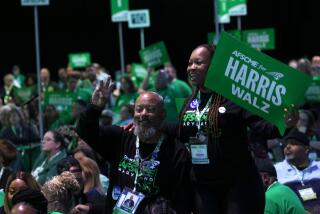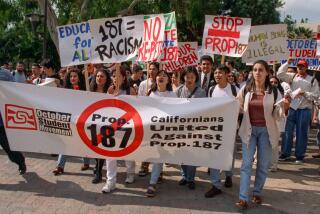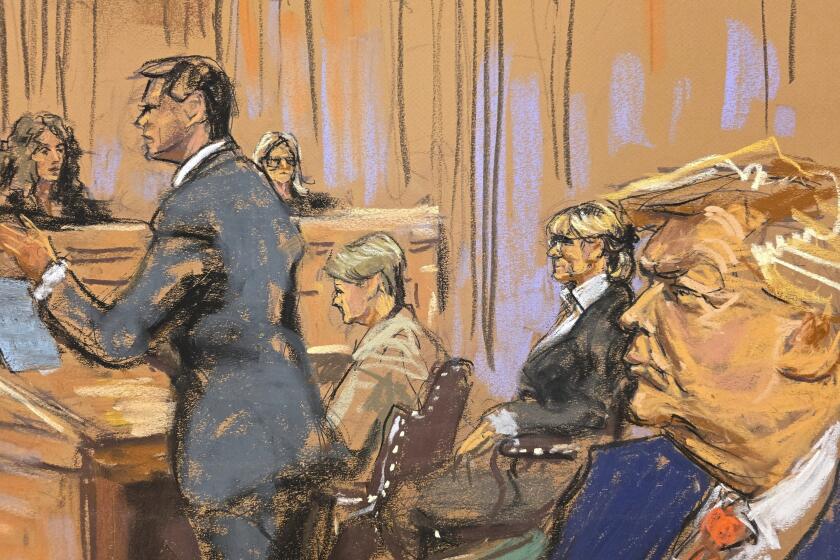Op-Ed: What a California political strategist looks out for on election day
While most people will spend election day obsessing over the fate of a few swing states, political strategists in California will do things a little differently. We’ll be checking results here at home to diagnose subtle shifts in the local electorate.
As a mostly one-party state, California has far more diversity of opinion than one might think. Not far below the surface of the standard Republican versus Democrat horse race is a complex political body that’s very much in flux. Here are a few examples of trends to watch.
Will Latinos vote in record numbers?
The June primary saw the Latino share of the electorate climb to more than 20%. Fueled by Bernie Sanders-inspired idealism among the young, older Democrats’ loyalty to Hillary Clinton and ire at Donald Trump, Latinos came out in force. And there’s reason to believe that they’ll come back for the general election. Political Data Inc. found that Latinos between 18 and 34 returned 73,888 ballots for the 2016 general election by Nov. 2, compared with 43,056 ballots by the same date in 2012.
Continuing higher [Latino] turnout could portend a dramatic shift of political power away from the San Francisco Bay Area.
Since most Latino voters reside in Southern California, continuing higher turnout could portend a dramatic shift of political power away from the San Francisco Bay Area, where voters are wealthier, whiter and more liberal than the state as a whole.
Currently, eight of California’s 10 statewide elected officials come from Northern California despite that region’s lower overall population. Historically poor turnout among Latino voters helps explains this imbalance.
A growing Latino voting bloc could lead to more Southern Californians elected statewide, and increase the likelihood that California will finally elect its first Latino governor or U.S. senator.
Will Hillary Clinton’s momentum help women down ballot?
The number of women in the California Legislature has declined in the last decade, from a high of 37 in 2006 to 31, or 26% of the total, today. More than a third of those elected officials are leaving due to either term limits or personal reasons, and at least a few will likely be replaced by men.
There’s a chance, though, that an influx of female voters drawn to the polls by Clinton’s historic bid will give other female candidates a boost. (Forty-eight women are pursuing seats in either the California Assembly or Senate.)
If lots of female candidates in California outperform their polling numbers, pundits may conclude that women voted in solidarity. If they don’t, they’ll figure that local policy concerns took precedence.
Will voters’ appetite for tax measures embolden the next Legislature to ask for even more?
2016’s very long ballot asks voters’ approval for tens of millions of dollars in state tax measures, many millions more in county and local taxes, $9 billion in statewide bonds and more than $30 billion in local bonds.
High turnout of Democrat and minority voters in California, spurred by anti-Trump sentiment, could lead to passage of most of these measures and hand Democrats a two-thirds supermajority in both houses.
The last time Democrats gained a two-thirds supermajority was 2012, a victory quickly erased in the 2014 mid-terms. Many liberals lamented not using that opportunity to increase a variety of taxes. If tax increases and bond measures do well on Tuesday, and if Democrats reclaim supermajority status, expect to see more tax hikes in the coming months.
Just how liberal?
For the better part of two decades the expansion of minority communities and the ascent of millennial voters, coupled with a declining share of middle class white voters, has solidified California’s status as a deep blue state. But just how liberal is California?
If ballot measures to end the death penalty, tighten gun control, legalize marijuana and institute pharmaceutical price controls pass, that will prove quite definitively that the home of Ronald Reagan, Richard Nixon, populist tax revolts and tough-on-crime measures has wholly embraced the progressive agenda. Or, if these measures fail, we’ll know that the state still has a silent majority of moderates.
Mike Madrid is a California political strategist.
Follow the Opinion section on Twitter @latimesopinion and Facebook
ALSO
It’s been an otherworldly campaign, and we’re not returning to Earth anytime soon
Tired, torn, disgusted by this election? You still have to vote.
What a California political strategist looks out for on election day
More to Read
A cure for the common opinion
Get thought-provoking perspectives with our weekly newsletter.
You may occasionally receive promotional content from the Los Angeles Times.










